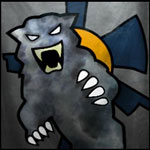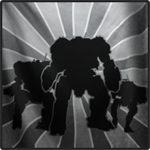 Belacose, on 01 August 2017 - 10:41 AM, said:
Belacose, on 01 August 2017 - 10:41 AM, said:
fodder for the bear_claws and foxes with shotguns in the middle of the night.
Am I really that terrifying? o.O I'm only a wee little 30-ton Kit Fox. Harmless as can be!
In all seriousness, though, it took me about a year to get good. I got into Kit Foxes looking for a challenge, because it has neither the hardpoint count of top-tier lights like Jenners, Firestarters and ACHs (back in the day, those were go-to lights), nor does it have the speed. It cannot escape from sticky situations very well, and it gets disarmed fairly quickly by observant enemies.
So to help you move on from POTATO SEASON to FOX SEASON, I will give you the following pieces of advice:
1) Know your enemy. No, really, KNOW your enemy.
That Linebacker has high agility, fairly good torso armor and favourable hitboxes for twisting. It's got loads of little weapons with short range. That Nova is much the same. Stay out of their range, aim for their legs instead of torso. 6 ERLL stalker, or AC5-boating Mauler/Direwhale/Kodiak? They can't turn for crap, and their weapons are mostly torso mounted. Strip torso and hit them when they're looking at someone else. 6 SPL ACH on enemy team? Stick to a buddy, and make sure you zone that ACH out. SPLs are very short ranged, and it won't do squat if he can't even get close. Gauss Kodiak? Get close and hump his legs. Those high mounts can't do squat against a short target!
And so the list goes on. This is part of the reason why scouts with comms are extremely important; in the first few minutes of the game when you're checking the enemy's composition, you don't need a full readout of the enemy's weapons. Some weapons are visually identifiable; e.g. AC20 with its wide, short barrel; Gauss Rifles with its long thin one; PPCs with glowy stubby barrels. Knowing what your enemy has is winning half the battle already, because you know what range you need to engage at to put yourself at an advantage. Or what terrain you need, for that matter. Good luck for that GR-using fatmech if he's fighting a Locust in urban warfare.
It also helps to know where each mech is likely to have its weapons or valuable equipment *cough* ECM *cough*. A HBR is strongly asymmetric, with potentially 5E and an ECM on its left side (your right, if it's facing you). An Atlas has its SRMs on the left side, and the big ballistic on the right. Executioners have a 7E right arm. So on, so forth. Knowing what part to hit lets you neuter the enemy's offensive much more easily than simply trying to drill through their CT.
For example, think of this situation. Your enemy is a HBR with 6 ERML, 2 LPL and an ECM. Knowing the loadout and the potential layout of the mech, you realise that it has 5 ERML on the right side, 2 LPL on the left, and one ERML in the head. The mech also has 50 armor + 30 struct in each ST, while it has 70 armor + 42 hp on the CT.
If you had enough damage to destroy a ST in one alpha, but not the CT, it would make sense to destroy the ERML side. Not only would it destroy the ECM, it would also destroy 5 ERMLs (reducing enemy alpha strike by 35), destroy one ST of a cXL (cutting enemy heat capacity and heat dissipation by 40%, and crippling its movement). Your alpha hits first, destroying a ST; it fires back with 1 ERML and 2 LPL, dealing 31 damage in return instead of 66. Your next alpha destroys his other CT, killing him by double ST destruction.
Now let's take the other option. Drilling CT. Your first alpha hits the CT, not destroying any critical equipment. It fires back with all its weapons still intact, dealing 66 damage. You fire again, killing the enemy. The result looks much the same; your team is one mech up, but the difference is that by disarming the enemy mech first, you end up taking far less damage for the same result. Even if you did fail to destroy the enemy mech, disarming the enemy leaves your allies with as much an advantage as literally destroying half the enemy mech.
The reverse is true also; if you don't know the enemy mech's layout, hitting a deadside (like a zombie centurion's LT/LA) is going to cost you a lot of heat for little to no gain. Therefore, know your enemy. Really,
really well. The difference is like punching a man in the gut, versus kicking him in the 'nads with a steel-capped stiletto heel. One really hurts, the other...eh.
2) Know the map. Really. KNOW the map.
Any light mech pilot knows that being caught out of position can range from being heavily damaged to being instantly gibbed. Therefore, have contingencies for when your actions don't go to plan. And contingencies when those contingencies don't work out. This should apply to all mechs, not just lights. Knowing escape routes, potential enemy ambush locations, clear firing lines and obstructed firing lines can all really help with getting the most out of your mech. It also helps to know where enemies only have a one-way entry point, and cannot easily go back the way they came. Tourmaline Desert has a lot of these, where ramps lead to overhanging cliffs with no way back up (except if you have JJs).
3) Know your weapon. No, really, KNOW your weapon.
ERPPCs travel at 1400m/s for Clans. ERPPCs travel at 1900m/s for Spheroids. PPCs move at 1300m/s for IS. Gauss moves at 2000m/s for both. If at the start you're trading long-range fire with other mechs, consider the following situation. You're at 600m from your enemy, and both of you are firing at each other. He's got C-ERMLs, and you've got C-LPLs. All too often, I see people twisting and turning like crazy the moment they get scratched by C-ERMLs at 600m, when they've got weapons that still work optimally at that range. You will out-trade them. Every. Single. Time.
The reverse is also true. When someone engages you in a close-range duel, and you've got ERPPCs with backup ERSL or ER Micros, don't use the PPCs. Their damage per heat is so abysmal, you'll likely overheat before you kill them. Use your armour as a resource and just trade it for some extra time to let your weapons come off cooldown and facepunch them again.
Lastly:
Fear the man who has practiced one punch 10,000 times. Don't fear the man who has practiced 10,000 punches one time each. Having many mechs is not a sign of true mastery; sometimes, it's those one mech pilots that are the truly terrifying ones in the game. Knowing the ins and outs of your own mech can be a very, very powerful thing.
Edit: As a footnote, if you really don't want to get shot by me, don't play heavies and assaults. I've got a bone to pick with them the size of the entire Inner Sphere.
Edited by Fox With A Shotgun, 01 August 2017 - 10:54 PM.









































